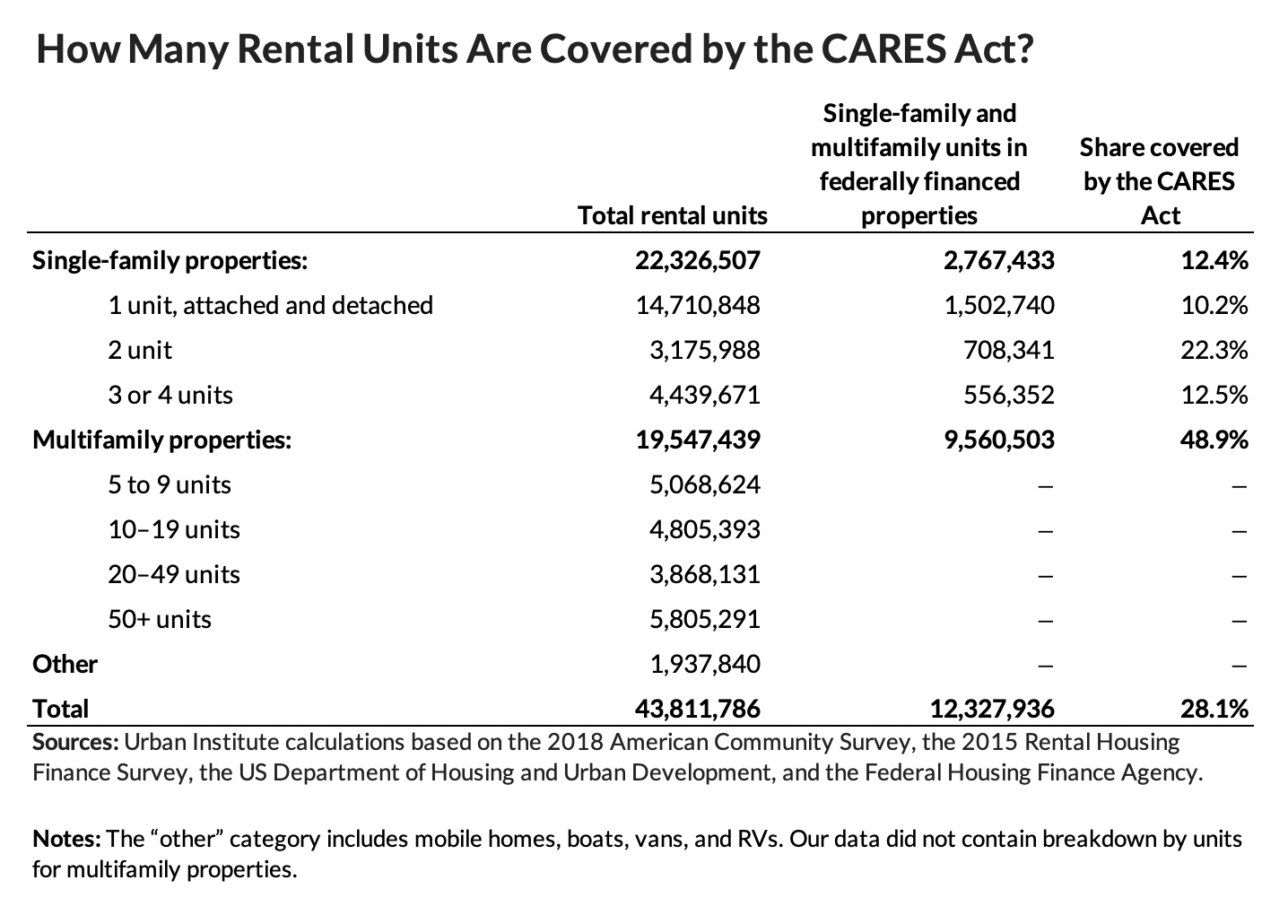
AP Photo/David J. Phillip.
Fannie Mae and Freddie Mac—the government-sponsored enterprises—and the Federal Housing Administration (FHA) have responded to the COVID-19 pandemic by halting evictions of renters living in properties they finance. In addition, the Coronavirus Aid, Relief, and Economic Security Act (CARES), passed last week, makes it unlawful (PDF) to evict renters living in single-family and multifamily properties financed by federally backed mortgages (i.e., by Fannie, Freddie, and Department of Urban and Housing Development [HUD] loans) and renters living in federally assisted housing.
This protection can help stabilize renters during an economically precarious time, but it doesn’t cover everyone. We estimate that eviction moratoria covering federally financed properties will apply to roughly 12.3 million (28 percent) of the 43.8 million US rental units.
What renter protections have been announced?
Initially, HUD announced a 60-day moratorium on evictions of renters from FHA-insured single-family properties. Fannie Mae and Freddie Mac announced forbearance of up to 90 days for their multifamily property owners—provided renters unable to pay rent are not evicted during forbearance—and required owners to document the hardship faced by borrowers and tenants. Fannie and Freddie also announced forbearance for owners of their single-family investment properties, but without a specific mandate to halt evictions. Multiple states and cities have also halted renter evictions during the crisis.
The CARES Act offers renter eviction protections that are broader in scope and could last longer than the above measures. It covers renters living in single-family and multifamily properties financed with federal mortgages (primarily those financed through Fannie, Freddie, or the FHA), and it also covers properties participating in the Low-Income Housing Tax Credit (LIHTC), as well as in several (PDF) federally assisted rental housing and voucher programs. The act provides for the following two types of eviction moratoria:
-
It halts evictions of renters living in single-family and multifamily properties with federally backed mortgages for 120 days after its enactment, regardless of whether the landlord receives forbearance.
-
It halts evictions of renters from federally backed multifamily properties whose landlords receive forbearance, effective for the duration of the forbearance, which is capped at 90 days.
The CARES Act covers 12.3 million rental units in federally financed properties
How many rental units are federally financed and thus protected by the CARES Act? According to the 2018 American Community Survey, roughly 43.8 million rental units in the US are occupied, of which 22.3 million are in single-family properties (i.e., one to four units) and 19.5 million are in multifamily properties (i.e., five or more units). The remaining 1.9 million are in other properties such as mobile homes, boats, vans, and RVs. Our estimates only cover federally financed units in single-family and multifamily properties and exclude units covered by LIHTC, federal assistance or voucher programs.
We estimate that nearly 2.8 of the 22.3 million single-family units (12.4 percent of units) are financed with federally backed loans through Fannie, Freddie, or FHA. We assume that all units in one-to-four-unit investment properties are rentals (2.3 million units) and that all units but one in two-to-four unit owner-occupied properties are rentals (0.5 million units.)
As for multifamily properties, the vast majority of federal financing flows through Fannie, Freddie, and FHA. According to the Federal Housing Finance Agency, Fannie and Freddie support approximately 8 million rental units in multifamily properties. According to HUD data, FHA-insured financing covers roughly 1.6 million units. That adds up to almost 9.6 million federally financed multifamily units.
The 2.8 million single-family and 9.6 million multifamily units total to over 12.3 million units, meaning 28.1 percent of the nationwide stock of 43.8 million rental units are federally financed and, thus, covered by CARES. Of the remaining 31.5 million rental units in the US that are without a mortgage or are financed through private mortgages, only those units covered by LIHTC, or various federal assistance or voucher programs are also protected by the CARES act. Estimating the number of those units is beyond the scope of this blog.

The CARES Act’s eviction protection provisions cover approximately 12.3 million occupied federally financed rental units, or slightly more than one in four total rental units in the US.
There are, however, operational impediments to this relief. How a renter would find out whether their landlord has a federal mortgage is unclear, and landlords may not know about available relief or how to take advantage of it. Renters are also unlikely to be aware of all the provisions and protections available under the 350-page CARES Act.
Finally, given renters are more financially vulnerable than homeowners, they’ll also need rental payment assistance. Solving for these issues will be a central concern for policymakers in the coming weeks and months.
Let’s build a future where everyone, everywhere has the opportunity and power to thrive
Urban is more determined than ever to partner with changemakers to unlock opportunities that give people across the country a fair shot at reaching their fullest potential. Invest in Urban to power this type of work.